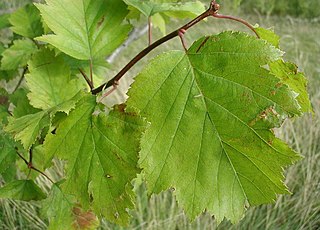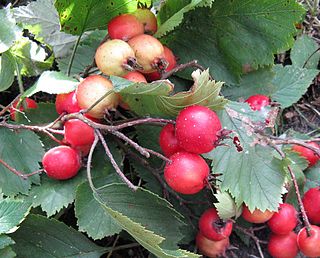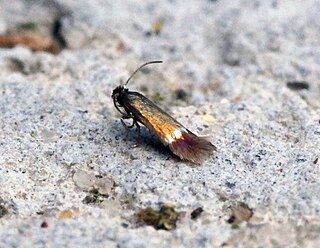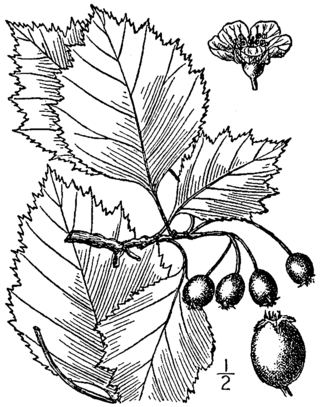
Crataegus, commonly called hawthorn, quickthorn, thornapple, May-tree, whitethorn, Mayflower, or hawberry, is a genus of several hundred species of shrubs and trees in the family Rosaceae, native to temperate regions of the Northern Hemisphere in Europe, Asia, North Africa, and North America. The name "hawthorn" was originally applied to the species native to northern Europe, especially the common hawthorn C. monogyna, and the unmodified name is often so used in Britain and Ireland. The name is now also applied to the entire genus and to the related Asian genus Rhaphiolepis.

Crataegus monogyna, known as common hawthorn, one-seed hawthorn, or single-seeded hawthorn, is a species of flowering plant in the rose family Rosaceae. It is native to Europe, northwestern Africa, and West Asia, but has been introduced in many other parts of the world.

Crataegus mollis, known as downy hawthorn or red hawthorn, is a species of plant that occurs in eastern North America from southeastern North Dakota east to Nova Scotia and southwest to eastern Texas. The range of this species is from southern Ontario and Michigan to eastern North Dakota and southward to Denison, Texas, and Arizona. This tree inhabits wooded bottomlands, the prairie border, and the midwest savanna understorey.
Cockspur or variants may refer to:

Crataegus heterophylla, known as the various-leaved hawthorn, is of uncertain origin. Its original native range is not known, possibly it was the Caucasus of Western Asia. Suggestions that it originated in Southeast Europe may be based on misidentification.
Camelthorn or camel thorn is a common name for several plants and may refer to:
Jerusalem thorn is a common name for several plants and may refer to:

Crataegus douglasii is a North American species of hawthorn known by the common names black hawthorn and Douglas' thornapple. It is most abundant in the Pacific Northwest.

Crataegus phaenopyrum is a species of hawthorn commonly known as Washington hawthorn or Washington thorn. It is widely grown as an ornamental plant, and can reach 10 m in height. The small red berry-like fruit grow closely together in large clusters and are food for squirrels and birds. They have a mild flavor and can be eaten raw or cooked. As with other species of hawthorn, the wood is hard and can be used to make tools.
Crataegus flava, common names summer haw and yellow-fruited thorn, is a species of hawthorn native to the southeastern United States from Virginia to Florida, west to Mississippi. Due to an error by Sargent the name C. flava was, and often still is, used for a different species C. lacrimata, which belongs to a different series, the Lacrimatae series. Flavae is another group of species that were thought to be related to the misidentified C. flava, and although it is now apparent that they are not related, the name of the group remains. Because the true identity of this species has only recently been discovered, the name is rarely used correctly. Individuals with red fruit occur; these have sometimes been assigned to a separate species, Crataegus senta.

Crataegus crus-galli is a species of hawthorn known by the common names cockspur hawthorn and cockspur thorn. It is native to eastern North America from Ontario to Texas to Florida, and it is widely used in horticulture. It is thought to be the parent, along with Crataegus succulenta, of the tetraploid species Crataegus persimilis.

Crataegus intricata is a species of hawthorn known by the common names Copenhagen hawthorn, Lange's thorn and thicket hawthorn. It is native to eastern Canada and the eastern United States. Its fruit are brown to red.

Crataegus submollis, known as the northern downy hawthorn, northern red haw, Quebec hawthorn, or hairy cockspurthorn, is a species of hawthorn that grows to about 7 m in height and typically carries large crops of red fruit.
C. orientalis may refer to:
Thorn(s) or The Thorn(s) may refer to:
Stigmella oxyacanthella is a moth of the family Nepticulidae, found in Europe and North America. The larvae are leaf miners feeding inside the leaves of trees and shrubs, such as hawthorn, apple and pear.

Stigmella hybnerella also known as the greenish thorn pigmy is a moth of the family Nepticulidae. It is found in all of Europe, in North Africa, the Near East, and the eastern part of the Palearctic realm. The larvae mine the leaves of trees and shrubs such as hawthorns and rowans.

Crataegus brainerdii is a species of flowering plant in the rose family known by the common name Brainerd's hawthorn. It is named for Ezra Brainerd (1844–1924), a renowned botanist and former president of Middlebury College, in Vermont.

Crataegus persimilis is a species of hawthorn, known by the common names plumleaf hawthorn and broad-leaved cockspur thorn, native to southern Ontario, Canada, and the US states of New York, Pennsylvania, Ohio, Kentucky, West Virginia, and Virginia. It is widely cultivated, particularly in Europe, as an ornamental. Its sporadic distribution in its natural range and certain of its morphological characters leads authorities to consider it a probable naturally occurring hybrid, with its most likely parents being Crataegus succulenta and Crataegus crus-galli. It is a tetraploid. Some populations may be self-perpetuating. Its 'Prunifolia' cultivar has gained the Royal Horticultural Society's Award of Garden Merit, and is considered one of its top 5 trees for smaller gardens.











